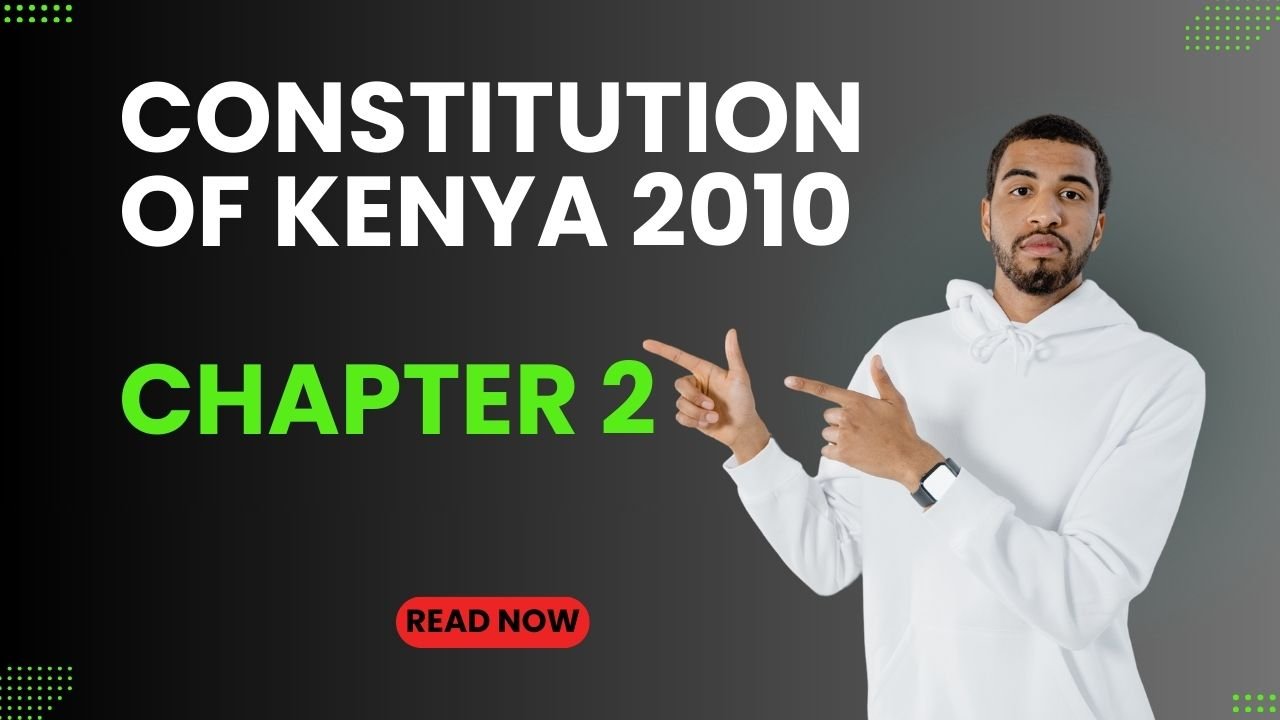Constitution of Kenya Chapter 2

Declaration of the Republic, Territory of Kenya & Devolution
Have you ever wondered what makes Kenya the country it is today, or how its system of government is structured? Chapter 2 of the Constitution breaks it all down for us.
This chapter includes Article 4, which establishes Kenya as a sovereign republic and a multi-party democracy; Article 5, which defines Kenya’s territorial boundaries; and Article 6, which outlines devolution and equitable access to services.
Let’s dive into these articles and see what they mean for all Kenyans!
Here they are…
Chapter 2: The Republic
Article 4: Declaration of the Republic
(1) Kenya is a sovereign Republic.
(2) The Republic of Kenya shall be a multi-party democratic State founded on the national values and principles of governance referred to in Article 10.
What Does this Mean?
Article 4(1): Kenya is a Sovereign Republic
This section declares Kenya as an independent and self-governed nation.
Key Points:
- Sovereignty ensures that Kenya’s citizens hold the ultimate authority over the country’s direction.
- Kenya has full control over its internal affairs, free from external interference.
- Governance, laws, and decisions are made by the people of Kenya or their elected representatives.
Article 4(2): Kenya is a Multi-Party Democratic State
This section states that Kenya shall be a multi-party democracy, allowing citizens to:
- Form or join political parties of their choice.
- Participate in free and fair elections.
- Elect leaders and representatives who reflect their values and priorities.
Kenya’s democracy is founded on the national values and principles outlined in Article 10, including:
- Patriotism and democracy.
- Human dignity, social justice, and inclusiveness.
- Equality, human rights, and the rule of law.
Article 5: Territory of Kenya
This article says…
(1). Kenya consists of the territory and territorial waters comprising.
(2). Kenya on the effective date, and any additional territory and territorial waters as defined by an Act of Parliament.
What Does this Mean?
Kenya’s Land and Territorial Waters
- Kenya’s borders encompass its landmass and territorial waters, the portion of the ocean extending from the coastline.
- These waters fall under Kenya’s jurisdiction, granting control over activities like fishing, resource extraction, and maritime security.
Territorial Boundaries and the Effective Date
- The Constitution’s effective date is August 27, 2010.
- Any future expansion of Kenya’s territory or maritime boundaries must be defined and approved by an Act of Parliament, ensuring transparency and accountability in boundary changes.
Article 6: Devolution and Access to Services
This article says…
(1) The territory of Kenya is divided into the counties specified in the First Schedule.
(2) The governments at the national and county levels are distinct and inter-dependent and shall conduct their mutual relations on the basis of consultation and cooperation.
(3) A national State organ shall ensure reasonable access to its services in all parts of the Republic, so far devolution in Kenya,as it is appropriate to do so having regard to the nature of the service.
What Does this Mean?
Article 6(1): Division into Counties
This clause establishes Kenya’s division into counties, listed in the First Schedule of the Constitution. These counties form the units of local governance under the country’s devolved government system.
Key Points:
- Counties bring government closer to the people, enhancing representation and accountability.
- Devolution ensures that local governments address the specific needs of their regions while contributing to national development.
Article 6(2): Distinct and Inter-dependent Governments
This section describes the relationship between the national government and county governments as:
- Distinct: Both levels operate independently in specific areas of governance, as defined by the Constitution.
- Inter-dependent: National and county governments must work together, consulting and cooperating to ensure effective governance and service delivery.
Key Takeaway:
This framework promotes collaboration while respecting the autonomy of each level of government, fostering efficient and inclusive decision-making.
Article 6(3): Access to Services Across Kenya
This clause ensures that national government bodies provide reasonable access to public services in all parts of the country.
Key Points:
- This provision promotes equality and fairness in governance, ensuring that no region or community is left behind.
- Essential services like healthcare, education, and security must be available to all Kenyans, regardless of their location.
- Service delivery must consider the nature of the service to ensure practical and efficient access.
Quiz Time: Test Your Knowledge!
Article 4: The Declaration of the Republic Quiz
1. What type of state is Kenya according to Article 4(1)?
- a) A military state
- b) A constitutional monarchy
- c) A sovereign republic
- d) A federated state
Correct Answer: (C)
2. What type of political system does Kenya have as per Article 4(2)?
- a) Single-party democracy
- b) Multi-party democratic state
- c) Direct democracy
- d) Federalist democracy
Correct Answer: (B)
Article 5: The Territory of Kenya Quiz
3. Kenya’s territory includes which of the following?
- a) Only the landmass of Kenya
- b) The landmass and territorial waters
- c) Only the landmass and airspace
- d) The landmass, territorial waters, and airspace
Correct Answer: (B)
4. How can Kenya’s territory or territorial waters be changed or expanded?
- a) By an Act of Parliament
- b) By presidential decree
- c) By a referendum
- d) By a military agreement
Correct Answer: (A)
Article 6: Devolution and Access to Services Quiz
5. According to Article 6(1), how is Kenya divided?
- a) Into provinces
- b) Into counties
- c) Into districts
- d) Into zones
Correct Answer: (B)
6. What must national government organs ensure according to Article 6(3)?
- a) Equal distribution of wealth
- b) Free services in urban areas
- c) Reasonable access to services across the country
- d) Maximum concentration of services in the capital
Correct Answer: (C)
Quotable Quote
The best way of learning to be an independent sovereign state is to be an independent sovereign state.
-Kwame Nkrumah
Finally…
Chapter 2 of the Constitution of Kenya 2010 defines the country’s national identity, governance structure, and territorial integrity. It emphasizes Kenya’s sovereignty, commitment to democracy, and equitable service delivery through devolution.
These provisions ensure that Kenya remains a fair, just, and inclusive republic, governed by its people and for its people.
Connect with us on Twitter(X) and Youtube for further discussions about governance of Kenya.
Have a safe week and thanks for reading!
The Civic Scoop Team




